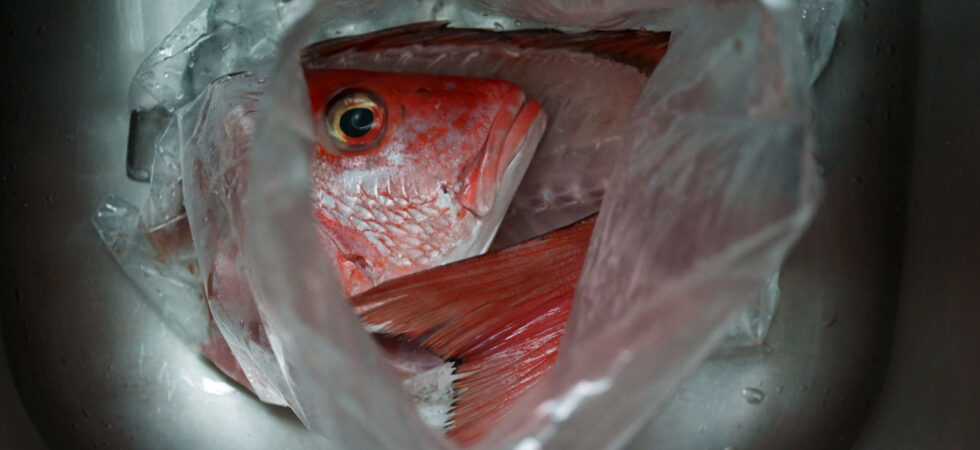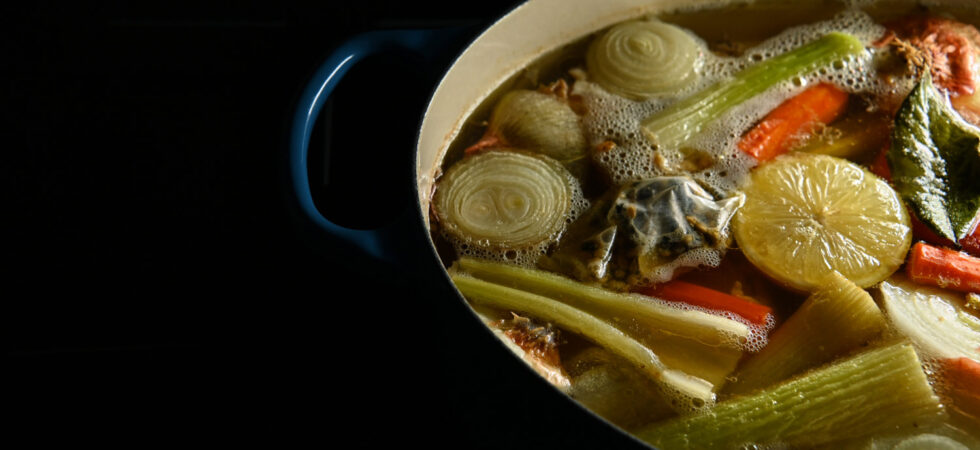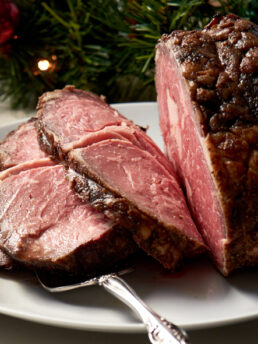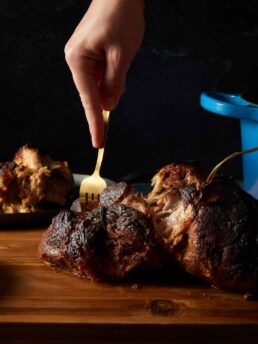How to Make Fish Stock with Fresh Ingredients

Fish stock made with fresh ingredients is a wonderful addition to all types of seafood dishes. It adds gentle body to soups and sauces and is an integral building block to more and better flavor when cooking with fish, scallops, octopus, etc.
If you have a fishmonger/fish market that breaks down and cleans the fish for you, fish stock can literally be made in less than an hour. No need to simmer for 6+ hours. I’m looking at you beef and chicken stock.

Get the Recipe: Homemade Fish Stock (fumet de poisson)
Ingredients
- ½ medium sweet onion
- 1 medium carrot
- 2 ribs of celery
- 1 tablespoon butter
- ½ teaspoon kosher salt
- 4 cups water
- 2 bay leaves
- 2 cloves of garlic, smashed
- 1, 4in x 4in piece of Kombu
- 4-6 sprigs of cilantro
- 1 teaspoon coriander seeds
- 1 teaspoon black or white peppercorns
- 2, ¼in x 1in slices of fresh ginger
- ½ in piece of lemongrass
- 1-2 lb of fish bones or heads, white-fleshed, saltwater fish preferred
Equipment
- chef knife
- 1 cutting board
- measuring Cups
- Measuring spoons
- 1 dutch oven or stock pot
- 1 wooden, flat-topped spatula
- 1 Fine Mesh Strainer
- 1 lidded container
Instructions
- Before starting with the vegetables, make sure your fish bones and head are well cleaned and placed in the refrigerator until ready to use.
- Next, roughly chop down the onion, carrot, and celery into bite-sized pieces and set them aside. Place a dutch oven or stainless steel pot onto your stovetop and bring the heat to medium-high. Add and melt the butter in the pot until it begins to froth and then toss in your veggies. Give them a quick stir and then sprinkle the salt over them. Continue to sauté the vegetables until they turn translucent and soften a bit. If they start to brown too much or char, turn the heat down to medium.
- After about 5 minutes, pour in the water and add the rest of the ingredients to the pot. Bring the heat down to medium-low or low and cook the fish stock for 30-45 minutes. You want to see only steam, NO bubbles. If you have a food thermometer, the temperature should not go over 185°F (85°C).
- Skim off any impurities and scum as your fish stock cooks. When done, turn off the heat strain through a fine mesh strainer. If you need to, you can pour everything through a colander into a bowl beneath (to catch all of the larger pieces), and then pour the liquid through a fine mesh strainer and into the container you want to store the fish stock in.
- Your homemade fish stock can be kept fresh in a refrigerator for 3-4 days or in the freezer for up to 3 months.
Notes
- This recipe makes about 3 cups (720ml) of stock.
- Don’t panic! If your stock bubbles, cooks for a little too long, or the bones are agitated too much, the only thing that will happen is the stock may become cloudy and taste fishier. (see FAQ)
Nutrition
Frequently Asked Questions
Don’t worry too much about it. The precision in temperature and time given in the instructions is for a restaurant level, clear broth.
If the temperature gets too hot, turn it down. It’s okay to boil for a few minutes without bringing out any unwanted flavors from the fish. But, just under boiling is the way to go. There will be more scum if the stock boils. Skim off as much as possible.
And, if the fish stock cooks too long the fish bones/cartilage and meat will break down more. Depending on how much longer you cook the fish stock, it may cloud the water a bit. The flavors will be more vegetal thanks to the mirepoix (carrots, onion, celery) but you will also have a more gelatinized and concentrated stock. So, it’s not the end of the world.
Oh, but you can. You just have to be smart about it. Once you have strained off the fish stock, put it back on the stove and turn the burner back on. Let it simmer on low again, until you are happy with the flavor and texture.
Absolutely! Onion tops, carrot peels, celery leaves: all are welcome in stock. Especially one cooked so quickly. Just make sure your scraps are in decent condition. If you didn’t clean your produce before peeling or it’s a little off, this stock will definitely take on those flavors. Fish stock, isn’t as robust as roasted chicken or beef broth and won’t hide any aromatics that are past their prime.
If you want to use scraps for stock and lessen your food waste, start keeping a bag of vegetable scraps in your freezer. You can add to it and then use it’s contents whenever you are making stock.
The best fish to use in fish stocks are white-fleshed, saltwater fish. A few great options are snapper, halibut, cod, tilapia, sea bass, cobia and amberjack. These will impart a fresh fish flavor without adding an oily texture to the stock.
I’m not saying you cannot use salmon for fish stock, just that it’s applications should be limited to salmon dishes like say, a hearty salmon chowder. Salmon can be an overpowering flavor in more subtle seafood dishes.
You can get bones one of two ways.
1. You can buy a whole fish, fillet it, and keep the head and spine for stock.
2. You can go to a local fish market and ask for them. Depending on the fishmonger, they may charge you very little if at all for the requested items.
Filleting fish is precise business. I don’t think I could do it justice by writing out instructions. And, since I don’t have video for this recipe yet, use this one by Kunihiro to help. It’s wonderfully done with great direction and visuals.
If you decide to fillet your own fish, please make sure you do a few things:
1. Keep everything clean;
2. Keep the fish as cold as possible at all times;
3. Snip off the gills if you intend to make stock with the scraps;
4. Make sure to clean all of the blood from the fish bones.
To clean your fish bones and heads, run them under cold water for 10 minutes using your fingers to remove as much grime and blood as possible. This may take a few washes if you miss some.
Optional: If you want to really make an effort, soak the pieces in ice water for an hour before rinsing.



